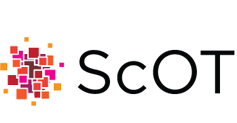Search scenarios
Ideas for enhancing search, building navigation and connecting curriculum to collections with ScOT webservices. Leverage ScOT relationships and attributes with sample queries available at the ScOT SPARQL Endpoint
Faceted search
All ScOT concepts are arranged in a hierarchy. The taxonomny structure can underpin faceted search in search algorythms. For example, a user searches for the Chemistry concept "Mixtures". ScOT acts as a special search index that adds all narrower and narrower-transitive concepts to the query, so the user retrieves resources tagged with 'Mixtures', 'Colloids', 'Aerosols', 'Liquid foams', 'Emulsions', 'Gels' etc. The Faceted search SPARQL query makes all narrower concepts for a concept available for query expansion.
Curriculum connect
ScOT-tagged collections can be linked to machine-readable curriculum by comparing the ScOT concepts in each. For example Australian Curriculum elements are profiled with ScOT concepts, therefore links from resources with ScOT tags can be inferred to Australian Curriculum Content Descriptions. Further, the ScOT hierarchy can be used to link resources metadata to curriculum containing broader-transitive concepts. For example, resources containing 'Colloids', 'Aerosols', 'Liquid foams', 'Emulsions', 'Gels' are automatically linked to curriculum profiled with 'Mixtures'. The Curriculum connect SPARQL query uses Australian Curriculum SPARQL Endpoint to demonstrate inferences made between curriculum and ScOT.
Navigation
The ScOT hierarchy can be used as the basis for a left-hand side Navigation structure. Users can drill down narrower concepts, or follow links to associated concepts. The Navigation SPARQL query creates full-term relationship displays with broader, narrower and related concepts so users can browse related content.
Top concepts and Collections
ScOT concepts are organised in a hierarchy arranged under ten top concepts. These top concepts are often used to organise top down browsing from a high-level page (see also Navigation above).
In addition to top concepts, ScOT includes a number of collections. Collections are groups of concepts that may be sourced from different branches in ScOT. Collections can also be used as the basis for high-level navigation or faceting search. Identify collections and Top concepts sample queries are available at the ScOT SPARQL Endpoint
Redirects
People use different language to refer to the same thing. ScOT contains thousands of synonyms that act as redirects from user search terms to terms used in metadata. Use alternative and hidden labels to match user search language to match preferred ScOT labels in resource metadata. Use hidden lables to create search indexes for common misspellings and other lexical variants. The Redirects SPARQL query expands user queries to include synonyms and other lexical variants.
Another solution is the ScOT synonym ring which can also be accessed to extend Google's Customized Search Engine.
Did you mean
People sometimes use the same language but refer to different things. In ScOT, homographs are indicated using parenthetical qualifiers -- ( ) -- within labels. For example:
- Stars (Polygons)
- Stars (Universe)
- Stars (Celebrities)
Create Did you mean pages, prompts or alerts when user queries match qualified terms. Use the SPARQL Endpoint to identify user search terms that match ScOT qualified terms. Present users with homographic alternatives to refine search. The Did you mean SPARQL query gets all qualified labes instances so users can refine queries.
